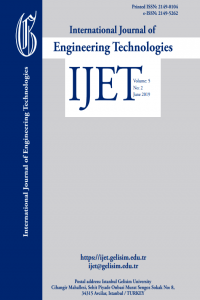Engineering Material Selection for Automotive Exhaust Systems Using CES Software
Cost, Exhaust system, Temperature, Corrosion Mass, Material, Service life,
___
- N. Arlt, Korrosions-und hitzebeständige Stahle in Abgassystemen. CTI Exhaust Materials Forum 21- 22.11.2007, Frankfurt, Germany, 2007.
- D. Askeland and P. Pradeep, The Science and Engineering of Materials. Thomson Engineering, 2005.
- M. Ashby, H. Shercliff, and D. Cebon, Materials Engineering, Science, Processing and Design. USA, Butterworth-Heinemann, 2007.
- ATI, Stainless Steels Type 439/AL 439 HP. ATI Allegheny Ludlum Corporation Blue Sheet Technical Data, Pittsburgh, Pennsylvania, USA, 1999.
- W. Callister, Materials Science and Engineering. New York, John Wiley & Sons, 2007.
- D. Gaskel, Introduction to the Thermodynamics of Materials. Taylor and Francis Publishing London SW1P 1WG, 1995.
- M. S. Chattha, J. Perry, R. L. Goss, C. R. Peters, H. S. Gandhi, Corrosion of aluminized low carbon steel exhaust system in vehicles equipped with three-way catalytic converters and development of a protective polymeric coating, Ind. Eng. Chem. Res., 29 (7), 1438-1442, 1990.
- P. Gumpel and C. Hoffmann, Corrosion resistance of stainless steels to wet condensates in automotive exhaust systems. Proceedings of the 6th European Stainless Steel Conference, Helsinki, 2008.
- D. Green, R. Hannink and M. Swain, Transformation Toughening of Ceramics. Boca Raton: CRC Press, 1989.
- Y. Inoue and M. Kikuchi, Present and future trends of stainless steel for automotive exhaust system”, Nippon Steel Technical Report No. 88, 2003.
- A. E. Ikpe, I. Owunna, P. O. Ebunilo and E. E. Ikpe, Material Selection for High Pressure (HP) Turbine Blade of Conventional Turbojet Engines. American Journal of Mechanical and Industrial Engineering 1 (1), 1-9, 2016.
- P. Lewis, K. Reynolds and C. Gagg, Forensic Materials Engineering: Case Studies. Boca Raton: CRC Press, 2003.
- F. Mathews and R. Rawlings, Composite Materials: Engineering and Science. . Boca Raton: CRC Press, 1999.
- Precision Automobile, exhaust system [online] available at http://www.precisionautosales.com/exhaust.php, 2000.
- J. Shackelford, Material Science for Engineers. Prentice Hall: Upper Saddle River, 2000.
- K. Zimmermann, Lightweight design in exhaust systems using tailored products. 9th International CTI Forum Exhaust Systems, January 26, 2011, Stuttgart, Germany, 2011.
- ISSN: 2149-0104
- Başlangıç: 2015
- Yayıncı: İstanbul Gelişim Üniversitesi
Ikpe Aniekan E., Orhorhoro Ejiroghene Kelly, Gobir Abdulsamad
Olurotimi Akintunde DAHUNSİ, Olayinka Oladele AWOPETU, Tunde İsaac OGEDENGBE, Tiamiyu İshola MOHAMMED, Taiwo Micheal ADAMOLEKUN
Chijioke OKECHUKWU, Olurotimi Akintunde DAHUNSİ, Peter Kayode OKE, İsiaka Oluwole OLADELE, Mohammed DAUDA
